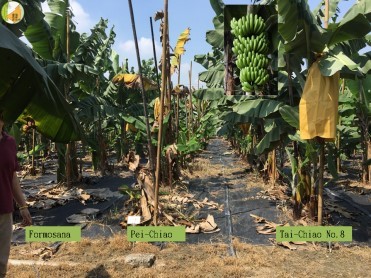Taiwan Banana Research Institute (TBRI) has been established to improve the livelihood of small growers and the competitiveness of Taiwan banana industry since 1970. TBRI endeavors to the collaboration with academic units in evaluating the effect of various microbes in promoting growth and healthiness of banana plants derived from tissue culture over the last 10 years. Currently, an endophyte, Burkhoderia cenocepacia 869T2, has shown its potential as a bio fertilizer and a bio pesticide especially against Foc TR4 (Fig 1). Another beneficial bacteria microbe which was isolated from Bacillus velezensis also showed its effect in preventing crown rot of banana. Two technologies developed in propagating healthy banana tissue culture seedling and applying somaclonal cultivar such as the newly bred resistant cultivar, Tai-Chiao No.8, to manage Foc TR4 are well recognized globally.


Fig 2. Expression of resistance to Foc TR4 by the newly bred cultivar, Tai-Chiao No. 8 (R), and its parent, Formosana (L), respectively,against the susceptible Pei-Chiao.
Taiwan: TBRI challenges panama disease of banana
Taiwan Banana Research Institute (TBRI) has been established to improve the livelihood of small growers and the competitiveness of Taiwan banana industry since 1970. TBRI endeavors to the collaboration with academic units in evaluating the effect of various microbes in promoting growth and healthiness of banana plants derived from tissue culture over the last 10 years. Currently, an endophyte, Burkhoderia cenocepacia 869T2, has shown its potential as a bio fertilizer and a bio pesticide especially against Foc TR4 (Fig 1). Another beneficial bacteria microbe which was isolated from Bacillus velezensis also showed its effect in preventing crown rot of banana. Two technologies developed in propagating healthy banana tissue culture seedling and applying somaclonal cultivar such as the newly bred resistant cultivar, Tai-Chiao No.8, to manage Foc TR4 are well recognized globally.
Fig 2. Expression of resistance to Foc TR4 by the newly bred cultivar, Tai-Chiao No. 8 (R), and its parent, Formosana (L), respectively,against the susceptible Pei-Chiao.